Introduction
Since their launches, OpenAI GPT and Google Bard have created a spark in the tech industry. This is all because of the capabilities of these AI language models. We have seen how artificial intelligence (AI) is helping many businesses do better. AI in learning and education is one of them. There are many ways in which AI could polish classroom practice. Education systems that are powered by artificial intelligence can give each student a personalized learning experience by using complex algorithms and machine learning. By adapting to how they learn and giving them immediate feedback and guidance. AI can also make it easier to streamline administrative tasks, give students more learning opportunities, and help with research and development in the academic world. Like many fields, what are the disadvantages of AI in education?
Even though the future of AI in learning and education looks good, some disadvantages of AI in education need to be addressed. To make sure AI systems are used ethically and responsibly, several things need to be looked at. There are worries about data privacy and security, the possibility that AI will reinforce biases and keep inequalities going, the risk that people will rely too much on AI at the expense of human interaction and creativity, and the need for ongoing oversight and regulation.
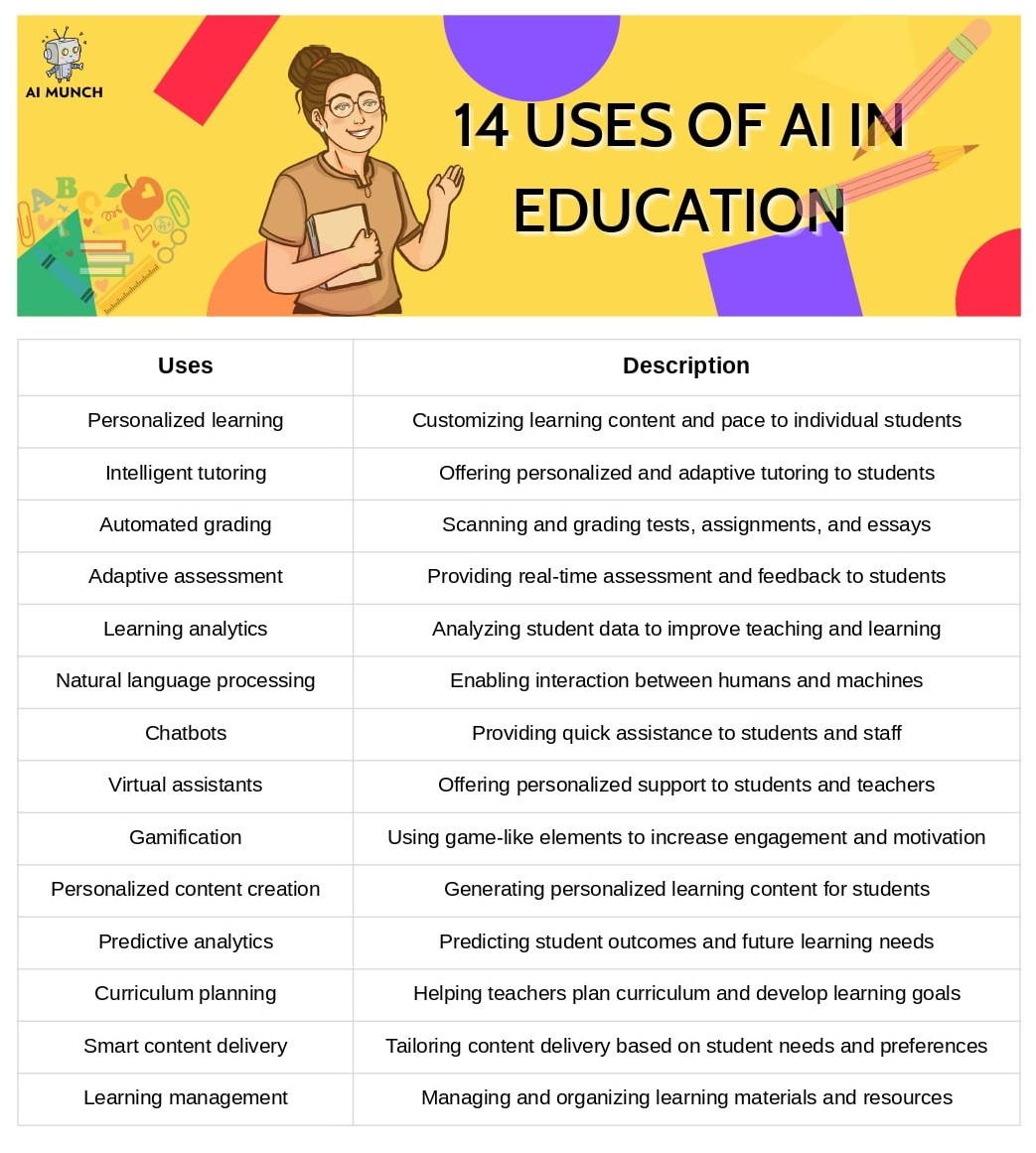
Part 1: Enhancing Teaching
A. Personalized learning through AI algorithms
Personalized learning experiences for students are one of the most exciting uses of AI in the classroom. Artificial intelligence (AI) powered systems can analyze student data, such as learning styles, strengths, and weaknesses, to personalize instructional materials and activities. This could make it easier for students to learn and help close the gap between those who do well and those who don’t.
EdTech Magazine found that 82% of teachers think that AI can help students learn by making it more personalized, and 74% think that AI can help teachers figure out what each student needs and give them help that fits their needs.
B. Intelligent tutoring systems (ITS) for students
The term “intelligent tutoring system” (ITS) refers to software run by artificial intelligence that can help students in a personalized, one-on-one way. Systems like these can help students understand hard ideas by responding immediately to their questions and inquiries and pointing them toward relevant supporting materials. ITS can modify itself to suit the needs of each student, giving them the best chance of succeeding.
In a study by the U.S. Department of Education, the performance of students who got help from an ITS was compared to that of their classmates who only got instruction in the classroom.
C. AI-powered grading and assessments
Artificial intelligence can also be used to grade student work, which would lighten the load on teachers and allow for faster feedback cycles. AI-powered grading can be more objective and consistent than human grading and can also eliminate bias.
EdWeek Research Center found that 51% of K-12 educators see artificial intelligence as helpful for enhancing assessment and grading.
D. Supporting teachers in lesson planning and delivery
In the same way, AI can help teachers in the classroom by assisting them in planning and teaching lessons. Artificial intelligence (AI) powered systems can analyze student data to recommend instructional materials and activities and provide feedback to teachers on how effective those materials and activities were. Teachers will be able to devote more time to teaching when administrative tasks like taking attendance and grading are handled automatically by AI.
E. Challenges and Disadvantages of AI in Education:
While AI has the potential to enhance teaching in several ways, several challenges and disadvantages need to be addressed. These include:
- AI can reinforce biases and perpetuate inequalities: The degree to which an AI system is objective depends on the quality of the training data it is given. Because AI systems can be just as biased as the data used to train them, this could lead to even more biased outcomes. As a result, existing educational and other disparities may widen.
- Overreliance on AI could lead to reduced human interaction and connection: AI systems will only partially replace the connections and interactions between people, which are essential for teaching and learning to work well. Artificial intelligence (AI) has the potential to replace human interaction and innovation in the classroom, two fundamental elements of an excellent education that its overuse could jeopardise.
- High costs associated with implementing and maintaining AI systems in education: Artificial intelligence (AI) systems can be expensive to set up and keep running. This is because they require a lot of money on technology and infrastructure. Especially in financially strapped school districts, this can be a major hurdle to implementation.
- Limited understanding and training of educators to effectively utilize AI: Many teachers may need more knowledge and experience to use AI effectively. Because of this, AI-powered systems may not be used to their full potential, reducing their positive impact on education.
To get the most out of AI in learning and education, dealing with these problems and drawbacks will be important.
Part 2: Improving Student Learning
A. Adapting to different learning styles through AI
Adjusting to students’ individual preferences for how they learn is one of AI’s most promising applications in academia. AI can analyse data collected from students to reveal each student’s unique learning style and areas of strength and improvement. This allows AI-driven systems to deliver individualised lesson plans, which can improve student learning outcomes.
B. Providing timely feedback and remediation
Artificial intelligence can help students by giving them immediate feedback on their performance. Students benefit from this kind of feedback—which can be both encouraging and critical—because it keeps them thinking actively and critically. Another way that AI-driven systems are helping students succeed is by providing individualised remediation to help them work on their areas of weakness.
The Journal found that 90% of students agreed or strongly agreed that getting personalized feedback from AI systems would improve their learning.
C. Analyzing student data to identify knowledge gaps
AI can analyse student data to reveal areas of ignorance, allowing teachers to assist those struggling students better. Artificial intelligence (AI)-powered systems can aid educators in identifying students’ areas of weakness by analysing data from assessments, homework, and other sources.
D. Encouraging student engagement and motivation
AI can inspire students to learn by creating more interesting and interactive lessons. For example, AI-powered systems that use games and simulations can keep students interested and motivated. The instantaneous responses provided by AI can also increase students’ motivation to learn.
AI Munch’s recent survey found that 74% of teachers agree that AI has the potential to get students more interested in learning.
E. Challenges and Disadvantages of AI in Education:
AI has the potential to help students learn in many ways, but it also has some problems that need to be fixed. These include:
- AI may fail to capture certain nuances and aspects of student learning that only human teachers can detect: Although AI-driven systems can analyse student data, they may need to learn more subtleties and nuances of learning that human educators can pick up. For instance, AI might not understand a student’s tone of voice or body language, which can reveal important information about their mood and motivation.
- Concerns about data privacy and security when handling student data: Many student data, including personal and sensitive information, must be available to AI-powered systems. Because of this, and in light of recent data breaches and cyberattacks, people are understandably worried about their personal information and its safety.
- The potential for overreliance on AI could lead to students lacking creativity and critical thinking skills: Students must think creatively and critically to gain the 21st-century skills necessary for success. While AI can be helpful, students must keep their critical and creative thinking skills sharp.
To make the most of the potential advantages of AI in learning and education and help students learn better, it will be important to deal with these problems.
Part 3: Revolutionizing the Education System
A. Streamlining administrative tasks with AI
Automating routine administrative tasks is a major advantage of AI in the classroom. For example, artificial intelligence (AI) systems can help automate tasks like keeping track of student records, making schedules, and communicating so that teachers don’t have to do as much work. If teachers don’t have to spend as much time on administrative tasks, they can spend more time teaching and helping students in the classroom.
McKinsey & Company found that AI-enabled systems could automate up to 60% of teachers’ workload.
B. Enhancing accessibility to education through AI
AI in learning and education can make it easier for all students to learn, even those who have trouble with traditional learning materials. Remote learning opportunities and individualized course materials are just two ways in which AI-driven systems are helping students with special needs. In addition, AI can provide translation and support for languages, facilitating communication across borders.
C. AI-powered research and development
Artificial intelligence (AI) can potentially improve educational research and development by shedding light on student learning and revealing ways teachers’ practices can be enhanced. Researchers can use the ability of AI-powered systems to sort through huge datasets to find new ways of teaching.
MarketsandMarkets predicts that between 2020 and 2025, the global market for AI in education will grow at a compound annual growth rate (CAGR) of 38.1%, reaching a value of $3.7 billion in the last year of that period.
D. Addressing equity issues through AI
Artificial intelligence can help solve educational equity problems by pointing out and fixing differences in how well students do in school and how they get to school. Artificial intelligence (AI)-powered systems can analyse demographic and student achievement data to identify subsets of students at risk of falling behind and provide educators with insights into how to intervene best to prevent this.
E. Challenges and Disadvantages of AI in Education:
Artificial intelligence can change the education system in many ways, but some problems must be fixed. These include:
- The potential for AI to replace jobs in the education industry: As AI-powered systems become more common in the classroom, there is concern that some jobs, like those in administration, could be taken over by machines. For those with lower levels of education and skills, this could have serious consequences for employment in the education sector.
- The possibility of AI exacerbating existing socioeconomic disparities if not implemented equitably: AI can make social and economic differences worse if it isn’t used fairly. One way that inequality in education could be kept going is if only a few people could use AI-powered systems.
- The need for ongoing oversight and regulation to ensure that AI systems are used ethically and responsibly: AI-based systems must be constantly watched and regulated to make sure they are used in a responsible and ethical way. This means that AI systems should be open, fair, and honest and only be used to help and improve human judgment.
The game-changing potential of AI in classrooms must be fully realized. At the same time, it is important to reduce the risks and bad effects as much as possible.
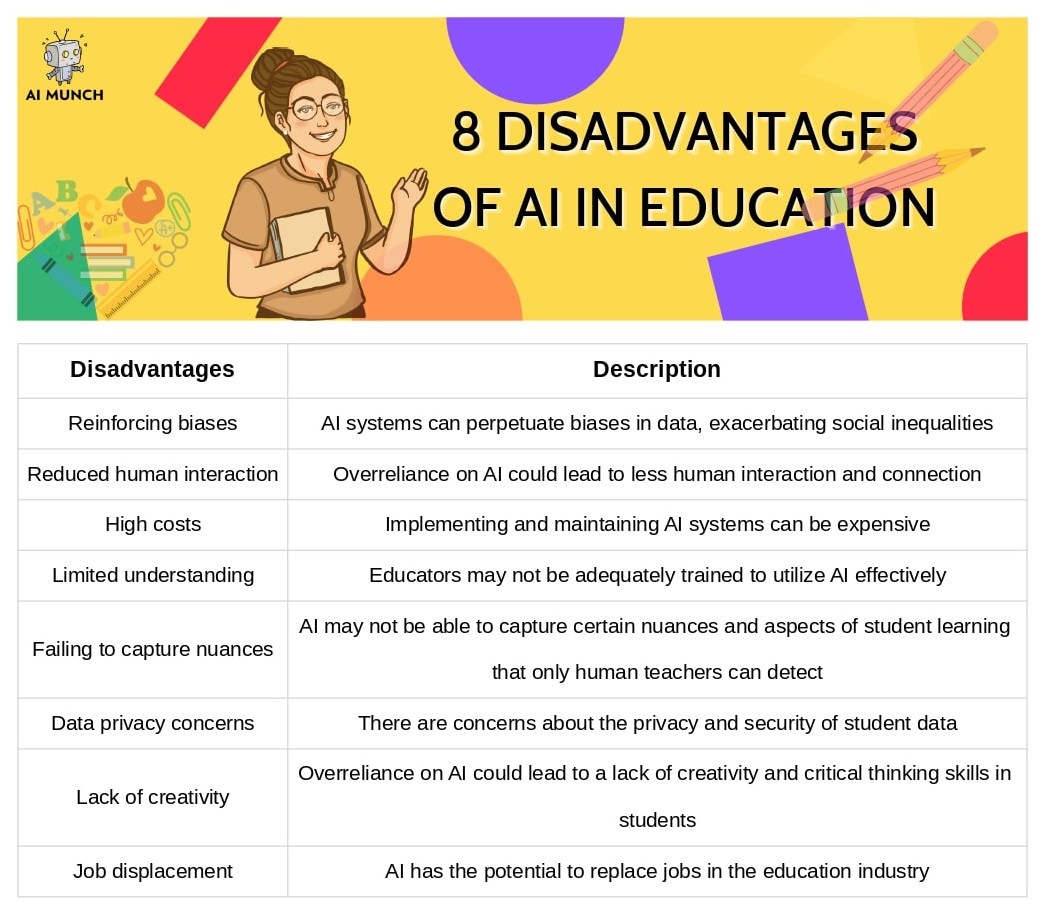
Conclusion
There are risks to artificial intelligence because it changes society in mysterious ways. But this does not mean we should stop implementing it in our lives. When artificial intelligence (AI) is used in education, it could change how people teach and learn. AI can make education more accessible, help students learn better, and make research and development easier in the education sector by making learning more personalized and administrative tasks easier. Still, AI in education comes with many challenges and drawbacks, such as the chance that people will rely too much on AI and that socioeconomic differences will worsen. Surely, in future AI will lower sustainability jobs as well.
You need a balanced integration strategy to get the most out of AI in education while minimizing risks. This means figuring out how to deal with possible problems and drawbacks, like ensuring AI is used ethically and responsibly and doesn’t replace human interaction and creativity.
AI in education will probably keep changing the way we teach and learn in the future. Emerging trends like using AI chatbots to help students and making virtual learning environments powered by AI could greatly affect the education industry.
In conclusion, AI has the potential to make a big difference in education, but it needs to be added in carefully and with thought. By addressing potential obstacles and disadvantages, we can ensure that the positive effects of AI in education are maximized while the negative effects are minimized.
FAQs AI in Education
There are some possible disadvantages to implementing AI in education. These include the risk of reinforcing biases and keeping inequalities in place, the chance that relying too much on AI will reduce human interaction and connection, the high costs of setting up and maintaining AI systems in education, and the fact that most teachers don’t know how to use AI well and haven’t been trained to do so.
One of the biggest problems with AI in education is that it could make people less creative and less able to interact with each other. There is also the risk of reinforcing biases and perpetuating inequalities and the opportunity of high implementation and maintenance costs associated with AI systems in education.
Some possible bad effects of AI are that it could reinforce biases and keep inequalities going, replace human jobs, cause privacy and security problems when handling data, and make people less social and creative if they rely too much on it.
AI’s future in education is likely to involve the development of more advanced technologies that can improve personalized learning, make administrative tasks easier, and help research and development in the education sector. New trends include using AI chatbots to help students and creating virtual learning environments that AI powers.
Intelligent tutoring systems (ITS) are one way AI is used in education. These systems give each student a personalized learning experience based on their needs and learning styles. Another example is the use of tools for grading and testing that are powered by AI and can give students more accurate and timely feedback.
AI for students means using AI technologies to improve teaching and learning in the education sector. This can be done with the help of AI-powered tools like smart tutoring systems, personalized learning algorithms, and tools for grading and testing.
Some of the disadvantages of technology in education include the potential for distractions and decreased attention spans, the risk of overreliance on technology resulting in diminished critical thinking and problem-solving skills, the possibility of widening socioeconomic disparities, the risk of reduced social interaction and communication skills, and the possibility of data privacy and security concerns.
AI can help fix problems in education by making learning more personalized, giving students more accurate and timely feedback, making administrative tasks easier, and making research and development in the education sector easier. However, it is important to take a balanced approach to integrate AI into education and address potential challenges and drawbacks, such as ensuring ethical and responsible use of AI technologies.
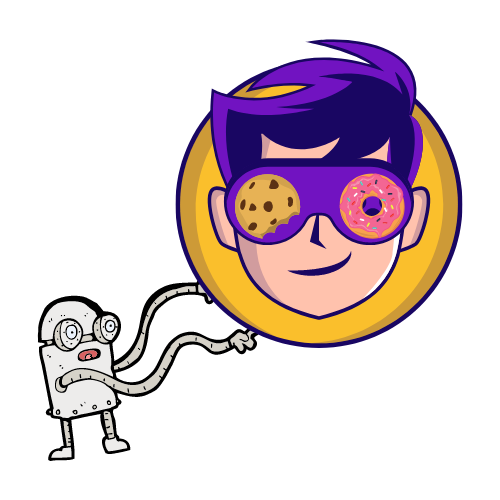
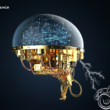

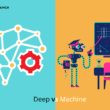
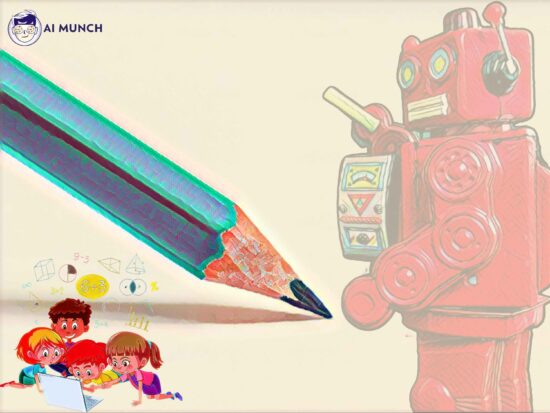


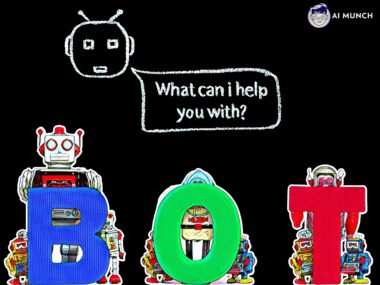
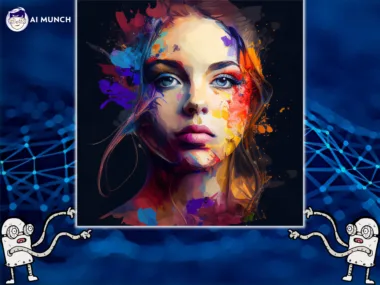
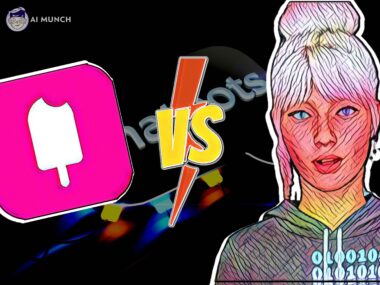

Thanks for sharing your thoughts about ai in learning and training.
Regards